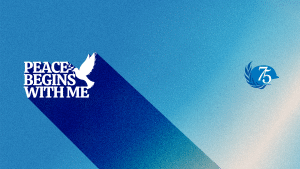UN Peacekeeping 75. Søren is a major in the Danish military who is currently deployed as a UN Military Observer in UNTSO, the UN Truce Supervision Organization in the Middle East.
When he joined UNTSO in September 2022, Søren was by no means a newcomer to international service for the Danish military. Before his current deployment, he had already served with UN Peacekeeping in South Sudan and prior to that in four missions abroad for NATO and its coalitions.

“It was in many ways different from the first four missions, and I wanted to try another UN mission, and this time as an observer,” Major Søren told the UNRIC website. In accordance with Danish national policy for Danish deployed abroad, we refer to him only by his first name.
75 years of UNTSO and UN peacekeeping
This year, 29 May marks the 75th anniversary of UN Security Council Resolution 50, which paved the way for the creation of UNTSO, the first UN Peacekeeping mission. The first group of military observers was sent to the region in June 1948 to observe and maintain the ceasefire in the 1948 Arab-Israeli war.
The Danish major is one of ten Danes serving with UNTSO. He is part of Team Wadi/Observer Group in Golan-Tiberias on the Israeli-Syrian border. A total of two to three peacekeepers man each observation post, where they observe and report on possible violations of the ceasefire.

-Creative Commons Attribution 3.0
“We are on duty in an observation tower for five to seven hours at a time,” Søren says. “In addition, there are several tasks we perform, from cleaning to cooking, maintenance to fuelling the generators. Furthermore, we use our free time for bodybuilding, reading books, watching movies or other hobbies.”
Cultural diversity

Each team consists of around a dozen observers from as many nationalities.
“Before deployment to UNTSO there was, among other things, a three-week-long course in Finland, focusing both on UN procedures and the cultural diversity that is a part of living and working in a multinational and multicultural environment. Most are therefore prepared for it and take the necessary precautions to make room for diversity.”

The biggest challenges, however, are not necessarily the cultural differences between staff coming from different corners of the world.
“The biggest challenges in working at the UN is probably the bureaucracy and the cooperation between the civilian and military elements. The bureaucracy is a time thief and kills initiative and change. Cultural differences between the civilian and military personnel can sometimes be an obstacle to cooperation… Each part would benefit from trying to understand better the tasks of each other.”
We make a difference

75 years after the first observers were sent to the Middle East, the peacekeepers are still there and there is no end in sight to the conflict.
“I still believe that we make a difference as peacekeepers,” Søren says. “First and foremost, our visibility and impartiality show that the outside world is interested in the situation in the area. I believe and hope that it gives the local people hope that they are not forgotten and that with time it will be possible to apply a real peace accord so people can live in peace and harmony with each other. I also think that our presence makes the parties think twice before they violate part of the ceasefire accord.”
Unique friendships

Cultural diversity can be a challenge in international operations, but it is also an asset.
“Cultural differences are also very enriching. It is always healthy to have other perspectives on fundamental values and it is thought-provoking and a basis for new learning.”
And this is exactly the most valuable experience that Søren has had as a peacekeeper.
“It is clearly the unique friendship that is created when you spend so much time together in a world where you are 100% dependent on each other,” the major says.

See also here.




